Articles

LucasArts' Secret History #9: Sam & Max Hit the Road Our Review
After enjoying a cult following as the stars of an underground comic, Steve Purcell's madcap duo were long overdue for a game of their own, an idea that became a reality in 1993 with Sam & Max Hit the Road. After parodying LEC projects in the company's internal magazine and making hidden cameos within many of the games themselves, a graphic adventure vehicle was perhaps the next logical step for the haphazard crime fighters. The project was headed by first time project leaders Mike Stemmle and Sean Clark, with Purcell himself serving as part of the core team. Like Day of the Tentacle, which came out the same year, Sam & Max is often associated with the golden era of LEC and of adventure games in general. Arguably, the early 90s were fertile for the genre in a way that was neither sustained nor ever reclaimed.
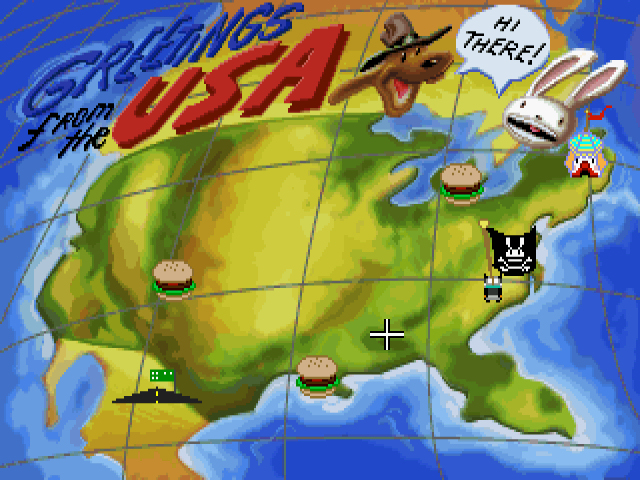
For the deprived souls who are unaware, I suppose some background is in order. "Sam & Max" or "Sam & Max Freelance Police" is a semi-obscure and irregularly published comic created by Steve Purcell, whose offbeat creations were first publicly exposed in the 80s. When Purcell joined Lucasfilm Games around that time, his characters came with him, and they soon became popular within the company to the point of acting almost unofficial mascots of sorts. Sam is an anthropomorphic, six foot dog in 1930s style police getup, and his partner Max is a three foot, "hyperkinetic rabbity-thing." Together they serve as dubiously altruistic private detectives who tackle rather unlikely mysteries and acts of malfeasance, often at the behest of the enigmatic Commissioner who will give them assignments over the phone. In their indestructible Desoto squad car, they patrol the streets of their grimy New York neighborhood and often places more exotic (such as ancient Egypt or the Moon) and bizarre, and with a surprisingly unassailable track record they solve twisted and improbable cases through casual indifference and the misuse of firearms.
Their adventures are light on reverence and heavy on absurdity, making for some of the most hilarious comics you're likely to read (and which have recently been re-released after years of shamelessly exorbitant eBay sales). Despite the lovable, edgy characters often wielding their oversized weapons and cruising and abusing in their Desoto, the creative solutions that they tend to find to their rather singular challenges make them a much better fit to the graphic adventure genre than a more action oriented one (though I wouldn't mind seeing an attempt at the latter).
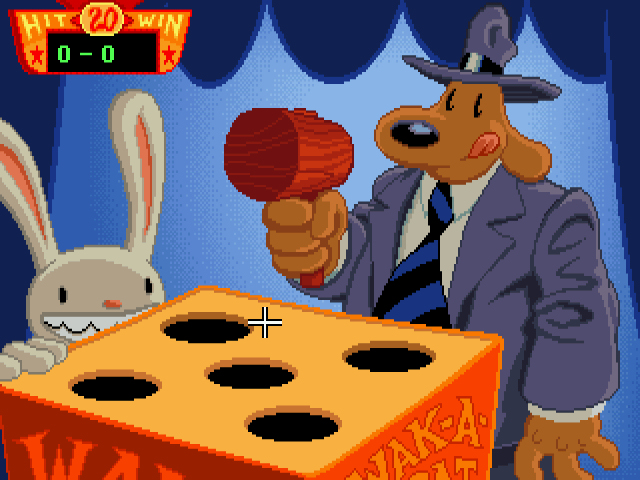
The story of Hit the Road is loosely based on one of the characters' full-length comic adventures, "Sam & Max On the Road," and sees the mayhem-causing investigators traveling all across the continental U.S. on a hunt for a bigfoot named Bruno, who ran away from his carnival freak show of employment along with his romantic partner, the giraffe-necked girl from Scranton. The case takes Sam and Max to cheap tourist traps and roadside attractions for clues (including such locales as the Biggest Ball of Twine and the Mystery Vortex), and acquaints them with a number of crazy suspects and grotesque miscreants (to scrape the tip of the iceberg: profane, wrench-bending psychics, hygienically unencumbered carnies, and intergalactic molemen) with the game primarily parodying Americana but making jabs at just about everything else it can in that patently insane and brilliant way that only Sam & Max can.
Along the way the pair discovers that Bruno and his equally freakish girlfriend have been kidnapped by unscrupulous country music star Conroy Bumpus, who employs animal abuse as a selling point of his performances. It's up to the self-accredited detectives to free the freaks from their bonds, avert catastrophe for the surviving race of bigfoots, and cause about as much damage to private property as possible while doing it. In short, it's another average day in the life of the Freelance Police.
The next in the long and noble line of SCUMM games, the gameplay of Sam & Max Hit the Road will be familiar to anyone accustomed with its forerunners, though Sam & Max does make a pretty active effort to change things up a bit. Instead of a set of verbs and inventory taking up the bottom fourth of the screen, the designers opt for an icon-based interface, likely something that low resolutions prohibited by default for older games, and somewhat similar to the interface Sierra pioneered around that time. It's a fairly significant adjustment, visually, from what came before, but the experience remains a mostly streamlined and user-friendly one. The verbs are replaced here by cursor icons, such as Sam's hand for picking up or an eyeball for looking, which can be cycled through by tab key or right-click to get to the action you need. It is also even possible to "use" Max, should the need arise, which it does in a few puzzles. Sam's inventory is brought up upon selecting a ragged cardboard box icon on the bottom left hand corner, allowing the game world to occupy the entire screen for the first time.
The icon driven approach extends to the conversations as well. Instead of text-based dialog trees, Sam is given a set of icons that represents the brand of verbal interrogation you can have him deliver: a question, an exclamation, a non-sequitur, and any relevant topics that apply. That the player doesn't actually know what Sam will say until he says it carries the benefit of jokes not being ruined, but on the flip side I'm not sure it was the ideal method either, since a limited knowledge of what you're about to say isn't exclusively desirable. The more recent Telltale episodes, which retain text-based dialog trees but don't necessarily give away what's best kept a surprise, seem to hit the right balance. Sam & Max's experimental interface is something of a mixed bag and did not see reprisal in the exact same form, but did prove to be influential insofar as it streamlined the presentation.
Sam & Max Hit the Road has a lot to offer, but what it will always be remembered for is its humor and writing, which is true to the spirit of the comics. The sheer inspired absurdity of the proceedings and the laugh-out-loud dialog are the primary driving force. More so than the main story or the puzzles, the exchanges between characters might be the biggest draw here. Oftentimes, you'll find yourself having Sam and Max talk to each other just to hear whatever hilarious, and often slightly disturbing nonsense is on their minds.
As your constant, non-playable companion, the rarely motionless Max is simultaneously a source of amusement and of hints, which he can deliver in veiled ways within the sarcastic banter. As usual, this is an LEC adventure where some of the best material comes from poking around for the sake of it, such as listening to all the recordings on the office answering machine or taking a quick peek inside the local convenience store. In fact, Hit the Road is one of the most quotable of LEC's adventures, and one need only boot up the game long enough to witness the iconic intro sequence to understand why it's never been forgotten.
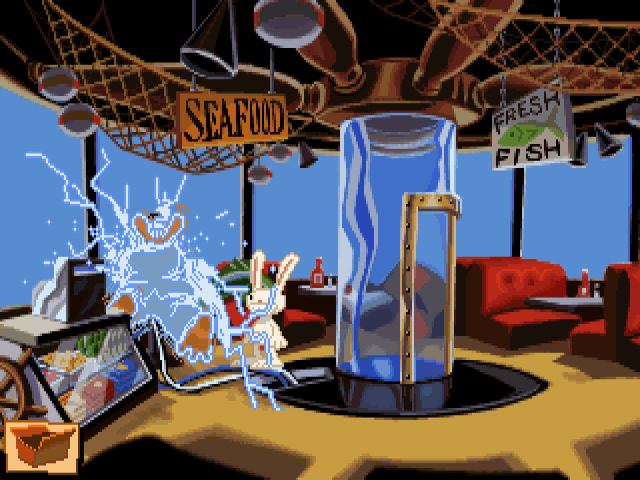
The absolutely superb art, to which Purcell himself heavily contributed, is the game's other major strength. The painted background illustrations, character design, and animation (all brought to life by of the likes of Peter Chan and Larry Ahern) is consistently top notch and holds up wonderfully, with the compression of the artwork hurting the game surprisingly little fifteen years later. I know the ageless quality of this game's visual side echoes sentiments I've shared about most other LEC games, but what can I say? These are simply gorgeous games that were brought to life by extremely talented people who always embraced the technology at their disposal to enhance, rather than constitute, the attractiveness of the product.
The insane universe of Purcell's comic creation is brilliantly realized here. Packing tons of detail and edginess in every one of its diverse and numerous screens, the game is a prime example of how an adaptation (of sorts) can excel when the original creator is around as a guiding force. Technically speaking, the production feels like it's on precisely the same level as Day of the Tentacle, with a few nifty lighting effects and other (at the time, at least) impressive little advancements in the tech sneaking appearances every now and then, adding to the visuals in subtle ways. There's even some fancy-pants primitive 3D modeling going on, such as in the helicopter and Biggest Ball of Twine tram animations. Really though, it's the raw art itself that makes this game such a pleasure to look at to this day.
As they are usually narrative-driven, adventure games tend to lack in replay value while they shine in other areas, and the genre occasionally makes attempts to address this "flaw." To this end, Hit the Road is the first LEC adventure to really make use of minigames. While the immortal Wak-a-Rat (which is exactly what it sounds like) is essential to the game's completion, most of these offerings, available at the three Snuckey's establishments scattered across the map, are unnecessary time wasters that have no bearing on the actual plotline. Ostensibly, these minigames were included to give players something to do during times when they got stuck and while I question the success in that particular regard, there's no question that diversions like Car Bomb are downright brilliant as self-contained shenanigans. Then there's Surfin' the Highway, accessible on the map, which is a decidedly less successful effort (as most action oriented sequences implemented with the SCUMM engine tended to be) that continues to baffle experts to this day. The minigames in Hit the Road are as memorable as any other aspect of the game and almost always in a good way. Their inclusion is also a bit of foreshadowing for adventure titles that would use arcade bits more liberally.
On the audio side, Hit the Road more than keeps up with the company's high standards. The still novel digital sound effects are of a similar vein to DOTT's (and in fact, the two games share many of them) and duly serve their purpose, appropriately supplying a loud crash or a painful thud when it's comedically useful. The iMUSE-utilized MIDI soundtrack, composed by Clint Bajakian, Michael Land, and Peter McConnell, reflects the eclectic nature of the game's visuals and leads, though it somewhat roots itself (particularly in the New York locales) in a jazzy, noir style that perfectly captures the gumshoe aspect of the characters while having enough attitude and personality to stay true to their boisterous natures as well. The music always feels appropriate to the scenery and is oftentimes rather catchy at minimum. (I've always been partial to Biggest Ball of Twine tune, personally.)
Notably, the game features a full-fledged, showstopping musical number where Conroy Bumpus performs a vocal country tune with some electrifying surprises. It's brilliantly hilarious and disturbing at the same time, and thus about as Sam & Max as you can get.
The voice acting of the game stands with Day of the Tentacle as one of the best early efforts in gaming, with the jokes actually being improved, rather than hurt, by the performances. (This was also the last adventure game which LEC offered a dual floppy and CD "Talkie" release. Subsequent adventure games were CD-based only.) Bill Farmer, who was at the time and remains Disney's current voice for Goofy, and already familiar Nick Jameson star as the title characters, and do an excellent job of bringing the not-so-cuddly animals to life while delivering the jokes with a pitch perfect pizzazz. Like DOTT, I'd say Hit the Road is as good as this stuff gets in 1993, and established fans were completely happy with Farmer and Jameson's work (and the consensus seems to be that they were far superior to the voices in the Saturday morning cartoon), and it's no surprise that Purcell was involved in the casting. The supporting characters are equally well suited; from B-movie legend Evelyn Morrison to the accommodating vegetable lady, the casting is spot-on. Overall, it's another Grade A audio job from a company that made an expectation out of that caliber.
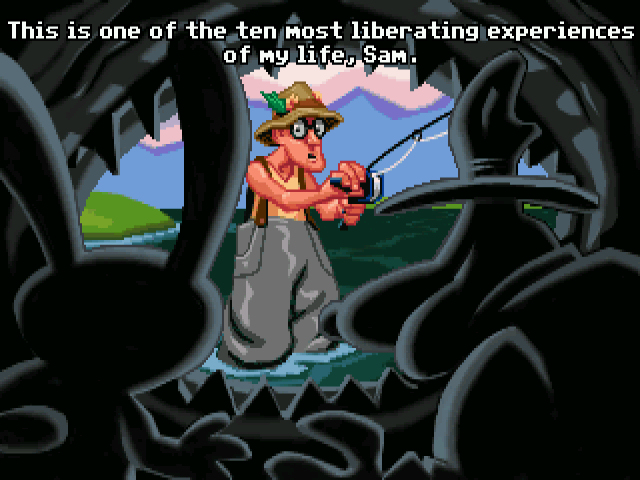
The uppercut of great that is all of the above makes any faults that Hit the Road exhibits incapable of tarnishing its badge too much; however, the game does have a significant setback that has only become more noticeable over the years – its puzzle design. While the bizarre and nonsensical nature of the obstacles that Sam and Max face are perfectly reflective of the characters' personalities, and they're certainly as creative and fun conceptually as you could ask for, their solutions are often maddening. Bluntly put, Hit the Road can be a rather frustrating game, and I don't think I'm falling victim to hyperbole when I say that some of the puzzles are downright ridiculous. Whether you're exercising unconventional uses for golf ball retrievers or trying to gain mechanical control over a rotating diner, Hit the Road's puzzles are a lot of things, but it's too rare that logical is one of them. Lateral thinking, if not access to a walkthrough, is a necessity.
What separates the puzzle design of Hit the Road from, say, Day of the Tentacle is that the latter had a genuine if cartoony sense of logic with maybe a few quirks along the way. Day of the Tentacle wasn't a much saner game than Sam & Max in terms of its style, but there was a rhyme and reason to how things worked once you got into the game's head. Not so with Hit the Road, where progress will too often be rewarded only to trial-and-error - there may be an appeal there to die-hard adventurers, but few others. True, in context Hit the Road is nothing obscene for 1993, where LEC was leaps and bounds above the competition, but after the superb puzzles of DOTT, Hit the Road's design philosophy can't be seen as anything but a step backwards. The game perfectly captures the spirit of its source material in the art, writing, and overall style, but it may have gone too far in extending the license's randomness to the puzzle solutions at the expense of the player's sanity.
Additionally, Sam & Max doesn't seem as consistently well-paced as some of its brethren. Like the SCUMM games before it beginning with Monkey Island 2, Hit the Road is a pretty large and nonlinear game, with Sam and Max navigating across a US map in their Desoto to various locations that are gradually made accessible to them. While the scope of the game is impressive, a byproduct is a somewhat dragging middle; it is the humor more so than the plot that sustains the interest. Hit the Road's problems are neither voluminous nor numerous, but they're not minor, and it probably requires more patience than the alternatives LEC was putting out at the time. For this reason, while I am definitely among the number who would hail Hit the Road as a classic game, I don't put it quite on the level with the studio's absolute best. 'Course, when the worst thing you can say of an adventure game is that it's not LEC's best, you're hardly unleashing anything slanderous.
The financial and critical success of the game along with the characters' utter lack of a backstory left plenty of room for sequels, and indeed several were attempted in response to the incessant clamoring of fans. Key word: "attempted." In fact, in recent years the subject of Sam & Max video games has become known more for what hasn't existed than for what has. After the cancellations of an Xbox game in 2001, and later a direct sequel by LucasArts itself in 2004, Sam & Max finally wound up in the capable (and in many cases, familiar) hands of Telltale Games and returned to gamers in episodic adventures that continue to be produced at the time of this writing. While these characters' appearances in whatever medium they choose to grace has been in the past pretty irregular, the duo has proven very durable, and they always seem to find themselves in a world where a modest but consistent group of people is waiting for more of their endearing tomfoolery with open arms.
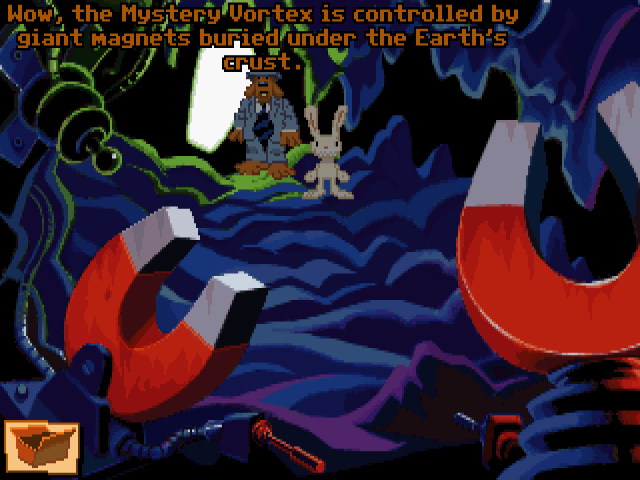
Although time has been a mite rough on some of its design choices, Sam & Max Hit the Road, nonetheless deserves its distinction as a genuine classic. It's an iconic graphic adventure that features some of most entertaining character interaction ever in a game, an irreverent brand of humor and uniquely wacky style that's in full force from the opening image all the way through to the interactive end credits. In what proves to be a theme when re-evaluating LEC's adventure catalog, time has done nothing to diminish the humor, art, or craftsmanship of the whole production, which remains a celebrated, all-time favorite. Sam & Max Hit the Road is a must-play for fans of the comic strip, graphic adventure enthusiasts, and anyone who likes games where characters, personality, and presentation take the front seat. Anyone who gets a laugh out of hitting a lagomorph skull with a wooden mallet should also not feel excluded.
A review by Jason, who likes to think that the Chief Bigfoot was voiced by an uncredited James Stewart
Four out of five Murray skulls
Pros: Hilarious dialog; madcap characters; amazing art and animation; above average voice acting; some great minigames; overall a brilliant and faithful adaptation of its comic book inspiration.
Cons: Puzzle design hasn’t aged well; pacing can be uneven; Surfin’ the Highway minigame makes small children cry.